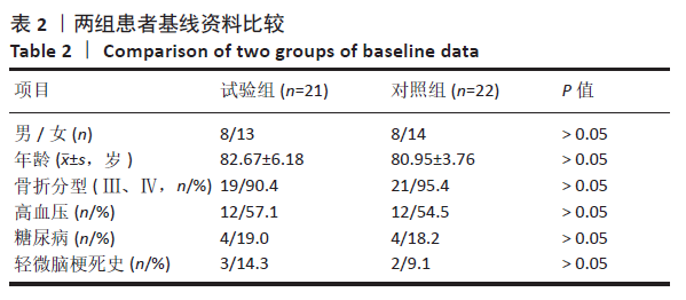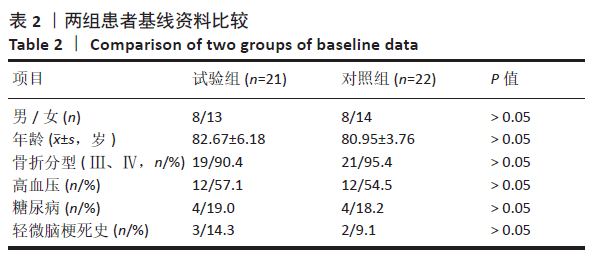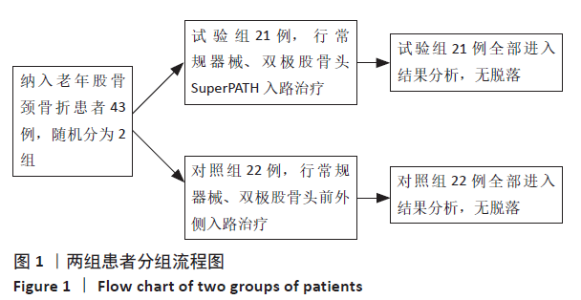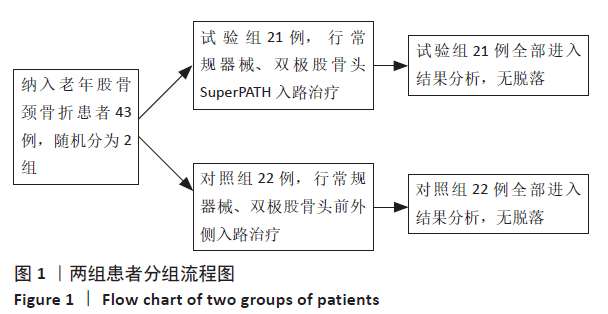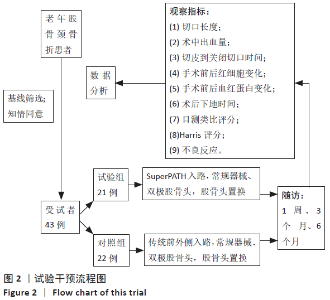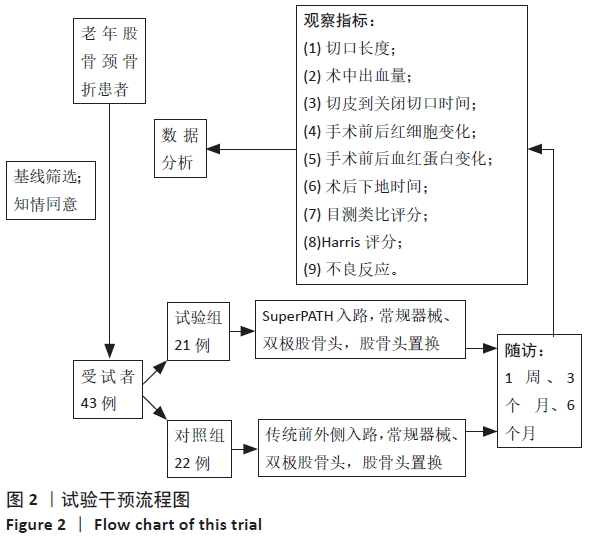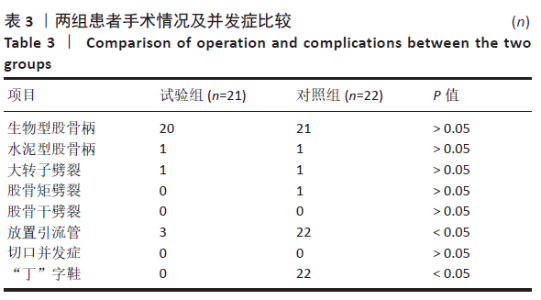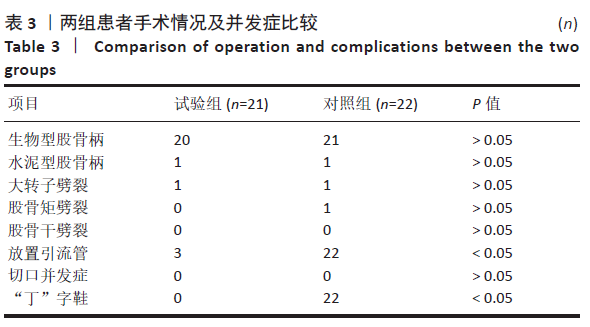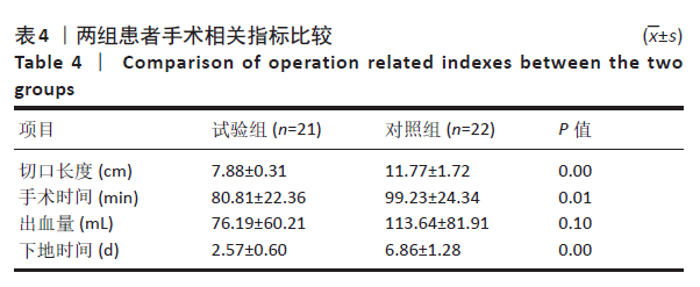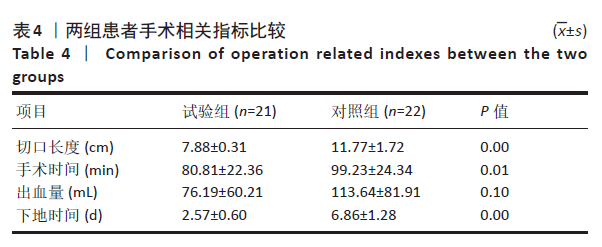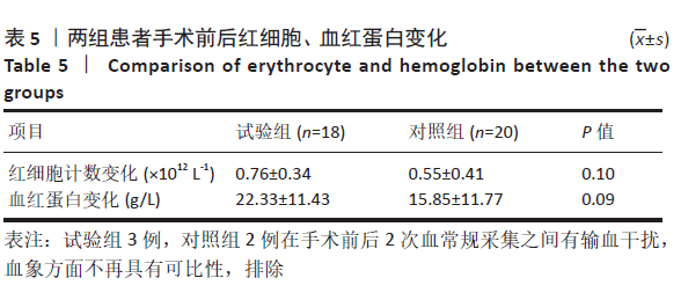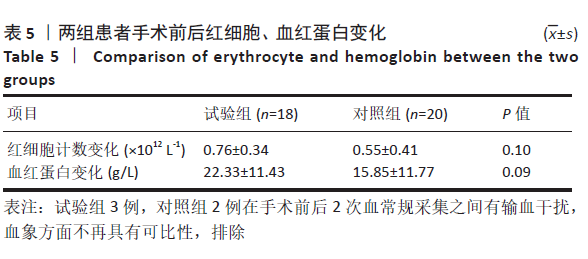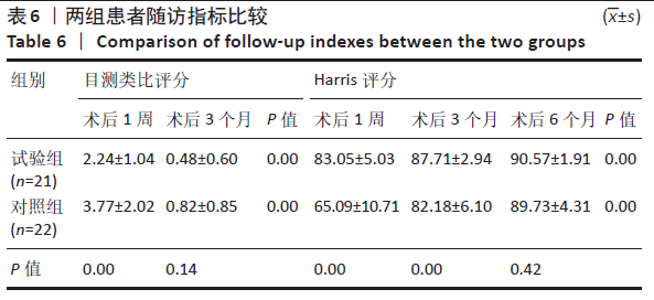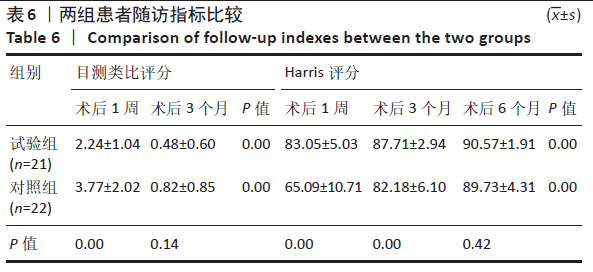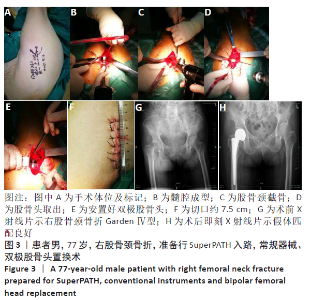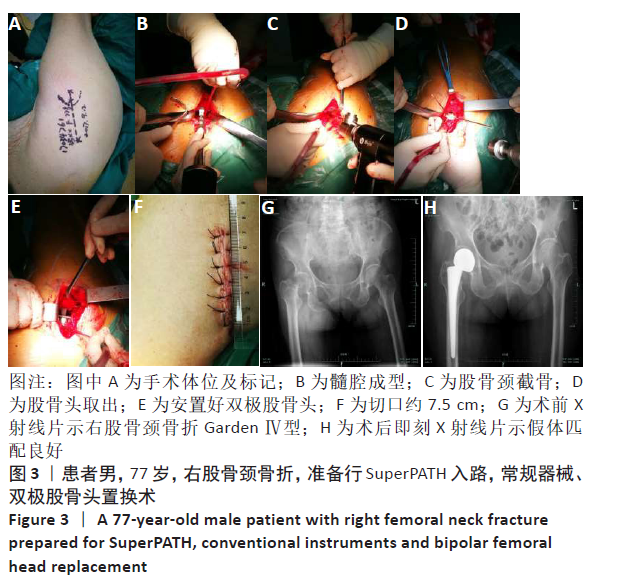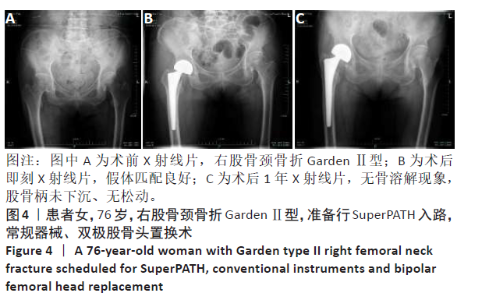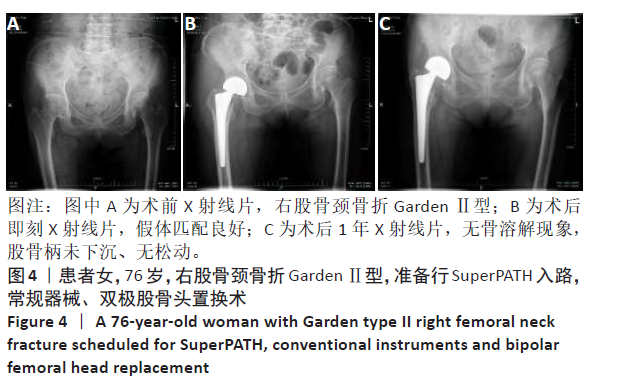Chinese Journal of Tissue Engineering Research ›› 2021, Vol. 25 ›› Issue (30): 4833-4838.doi: 10.12307/2021.270
Previous Articles Next Articles
Conventional instrument SuperPATH approach versus the anterolateral approach for femoral head replacement: a randomized controlled comparison of efficacy
Ji Dong, Xia Liangzheng, Jiang Yunyun, Wang Kang, Deng Yinghu, Zhu Dongqi, Yuan Zhongshan, Li Shenghua
- Orthopedic Center of Tongling People’s Hospital, Tongling 244000, Anhui Province, China
-
Received:2020-11-02Revised:2020-11-05Accepted:2020-12-07Online:2021-10-28Published:2021-07-29 -
Contact:Xia Liangzheng, MD, Chief physician, Professor, Master’s supervisor, Orthopedic Center of Tongling People’s Hospital, Tongling 244000, Anhui Province, China -
About author:Ji Dong, Attending physician, Orthopedic Center of Tongling People’s Hospital, Tongling 244000, Anhui Province, China -
Supported by:the Health Research Project of Tongling Health Commission, No. [2014]08 (to XLZ)
CLC Number:
Cite this article
Ji Dong, Xia Liangzheng, Jiang Yunyun, Wang Kang, Deng Yinghu, Zhu Dongqi, Yuan Zhongshan, Li Shenghua. Conventional instrument SuperPATH approach versus the anterolateral approach for femoral head replacement: a randomized controlled comparison of efficacy[J]. Chinese Journal of Tissue Engineering Research, 2021, 25(30): 4833-4838.
share this article
Add to citation manager EndNote|Reference Manager|ProCite|BibTeX|RefWorks
| [1] 郭徽灵,汤发强,颜来鹏,等.改良前外侧入路与后外侧入路人工股骨头置换术治疗老年股骨颈骨折的比较[J].中国骨与关节损伤杂志,2020,35(10):1050-1052. [2] CHOW J, PENENBERG B, MURPHY S. Modified micro-superior percutaneously-assisted total hip: early experiences & case reports. Curr Rev Musculoskelet Med. 2011;4(3):146-150. [3] DELLA TORRE PK, FITCH DA, CHOW JC. Supercapsular percutaneously-assisted total hip arthroplasty: radiographic outcomes and surgical technique. Ann Transl Med. 2015;3(13):180. [4] XIE J, ZHANG H, WANG L, et al. Comparison of supercapsular percutaneously assisted approach total hip versus conventional posterior approach for total hip arthroplasty: a prospective, randomized controlled trial. J Orthop Surg Res. 2017;12(1):138. [5] 夏良政,袁中山,朱东起.SuperPATH入路双极股骨头置换治疗老年股骨颈骨折[J].临床骨科杂志,2020,23(3):399-401. [6] 汪康,李胜华,邓英虎,等.改良SuperPATH入路双极人工股骨头置换术治疗老年股骨颈骨折早期疗效分析[J].中国骨与关节损伤杂志,2018,33(12):1276-1278. [7] 夏良政,李胜华,袁中山,等.普通双极股骨头 SuperPATH 入路治疗老年股骨颈骨折[J].中国组织工程研究,2018,22(19):2953-2960. [8] 陈华,夏良政,李胜华.前外侧入路人工双极股骨头置换治疗高龄患者股骨颈骨折疗效观察[J].中外医学研究,2013,11(16):121-122. [9] 张博,林源,王志为,等.前外侧入路半髋置换治疗股骨颈骨折伴脑梗死后遗症患者术后临床效果观察[J].首都医科大学学报,2016, 37(5):684-687. [10] 郭斌,杨建成,屠春晖,等.改良Hardinge 入路在全髋关节置换术中的应用效果[J].临床骨科杂志,2018,21(1):40-42. [11] CARDENAS-NYLANDER C, BELLOTTI V, ASTARITA E, et al. Innovative approach in total hip arthroplasty: supercapsular percutaneously-assisted. Hip Int. 2016;26 Suppl 1:34-37. [12] MITCHELL RJ, KAY AB, SMITH KM, et al. Early results of displaced femoral neck fragility fractures treated with supercapsular percutaneous-assisted total hip arthroplasty. Arthroplast Today. 2019; 5(2):193-196. [13] 张涵,员晋,兰海.SuperPATH微创髋关节置换术治疗老年股骨颈骨折[J].中华创伤骨科杂志,2018,20(5):400-405. [14] LEROY TE, HAYDEN BL, DESMARAIS J, et al. Early Outcome Comparison of the Posterior Approach and the Superior Approach for Primary Total Hip Arthroplasty. Arthroplast Today. 2020;6(3):508-512. [15] WANG XD, LAN H, HU ZX, et al. SuperPATH Minimally Invasive Approach to Total Hip Arthroplasty of Femoral Neck Fractures in the Elderly: Preliminary Clinical Results. Orthop Surg. 2020;12(1):74-85. [16] GOFTON W, FITCH DA. In-hospital cost comparison between the standard lateral and supercapsular percutaneously-assisted total hip surgical techniques for total hip replacement. Int Orthop. 2016;40(3):481-485. [17] CHOW J, FITCH DA. In-hospital costs for total hip replacement performed using the supercapsular percutaneously-assisted total hip replacement surgical technique. Int Orthop. 2017;41(6):1119-1123. [18] 梁晓雨,李晓光,薛探,等.SuperPATH微创全髋关节置换术于临床应用中的研究[J].中华肿瘤防治杂志,2016,23(S2):277-278. [19] 贾建波,禹宝庆,吴良浩,等.传统后路与微创SuperPath入路的半髋置换治疗老年股骨颈骨折疗效比较[J].中华老年骨科与康复电子杂志,2017,3(4):223-230. [20] 贾建波,禹宝庆,吴良浩.微创SuperPath入路人工股骨头置换术治疗老年股骨颈骨折的近期疗效[J].中华创伤骨科杂志,2016,18(11): 938-944. [21] 黄钢勇,夏军,魏亦兵,等.SuperPATH 入路髋关节置换术治疗高龄老年股骨颈骨折短期临床疗效[J].国际骨科学杂志,2016,37(5):331-336. [22] BODROGI AW, SCIORTINO R, FITCH DA, et al. Use of the supercapsular percutaneously assisted total hip approach for femoral neck fractures: surgical technique and case series. J Orthop Surg Res. 2016;11(1):113. [23] 吴良浩,禹宝庆,陈帆成.SuperPATH微创入路人工股骨头置换治疗老年股骨颈骨折:前瞻性、开放性、随机对照临床试验[J].中国组织工程研究,2017,21(7):1009-1014. [24] JIANBO J, YING J, XINXIN L, et al. Hip hemiarthroplasty for senile femoral neck fractures: Minimally invasive SuperPath approach versus traditional posterior approach. Injury. 2019;50(8):1452-1459. [25] MURPHY SB. Technique of tissue-preserving, minimally-invasive total hip arthroplasty using a superior capsulotomy. Oper Tech Orthop.2004; 14(2):94-101. [26] PENENBERG BL, BOLLING WS, RILEY M. Percutaneously assisted total hip arthroplasty (PATH): a preliminary report. J Bone Joint Surg Am. 2008;90 Suppl 4:209-220. [27] 韩晓飞,孙振中,顾三军,等.SuperPath 与Moore 入路全髋关节置换术治疗老年股骨颈骨折早期疗效比较[J].创伤骨科杂志,2018,20(10): 730-734. [28] TOTTAS S, TSIGALOU C, VERVERIDIS A, et al. Supercapsular Percutaneously Assisted total hip arthroplasty versus lateral approach in Total Hip Replacement. A prospective comparative study. J Orthop. 2020;21:406-415. [29] CHOW J. SuperPath: The Direct Superior Portal-Assisted Total Hip Approach. JBJS Essent Surg Tech. 2017;7(3):e23. [30] MENG W, HUANG Z, WANG H, et al. Supercapsular percutaneously-assisted total hip (SuperPath) versus posterolateral total hip arthroplasty in bilateral osteonecrosis of the femoral head: a pilot clinical trial. BMC Musculoskelet Disord. 2019;21(1):2. [31] JIANG H, WANG LH, JIN YX, et al. Supercapsular percutaneously assisted total hip arthroplasty versus conventional posterior approach: Comparison of early functional results. Acta Orthop Traumatol Turc. 2020;54(5):511-515. [32] RASULI KJ, GOFTON W. Percutaneously assisted total hip (PATH) and Supercapsular percutaneously assisted total hip (SuperPATH) arthroplasty: learning curves and early outcomes. Ann Transl Med. 2015;3(13):179. [33] LEI P, LIAO Z, PENG J, et al. Assessment of the Learning Curve of Supercapsular Percutaneously Assisted Total Hip Arthroplasty in an Asian Population. Biomed Res Int. 2020;2020:5180458. |
| [1] | Xue Xiaofeng, Wei Yongkang, Qiao Xiaohong, Du Yuyong, Niu Jianjun, Ren Lixin, Yang Huifeng, Zhang Zhimin, Guo Yuan, Chen Weiyi. Finite element analysis of osteoporosis in proximal femur after cannulated screw fixation for femoral neck fracture [J]. Chinese Journal of Tissue Engineering Research, 2024, 28(6): 862-867. |
| [2] | Tan Nengxian, Wu Wenzheng, Zheng Churong, Luo Lieliang, Gu Peng, Ouyang Chongzhi, Zheng Xiaohui. Finite element analysis of different fixation methods of partially threaded cannulated screws for treating vertical femoral neck fractures [J]. Chinese Journal of Tissue Engineering Research, 2024, 28(6): 873-878. |
| [3] | Zheng Jiafa, Song Xiufeng, Li Hongzhi, Zhou Jinming, Guan Shengyi, Yu He. Open reduction and internal fixation via the para-Achilles tendon approach for the treatment of posterior malleolus sandwich fractures [J]. Chinese Journal of Tissue Engineering Research, 2024, 28(6): 934-938. |
| [4] | Pan Yunchun, Wei Hongjun, Ren Guoqing, Zhang Qiliang. Comparison of gait and hip ambulation ability after total hip arthroplasty through different approaches [J]. Chinese Journal of Tissue Engineering Research, 2024, 28(18): 2846-2851. |
| [5] | Wan Jian, Wang Ning, Bei Chaoyong, Chen Yuanming, Wang Honggang. Two lumbar fusion regimens in treatment of single-level lumbar degenerative diseases based on propensity score matching [J]. Chinese Journal of Tissue Engineering Research, 2024, 28(12): 1914-1919. |
| [6] | Han Biao, Li Ji, Li Bin, Sun Bo, Zong Shuangle, Wang Hongrun, Li Dongmei, Li Ligeng, Wang Bin. Finite element analysis of optimal fixation method for femoral neck fracture with different reduction conditions [J]. Chinese Journal of Tissue Engineering Research, 2024, 28(12): 1810-1814. |
| [7] | Ke Yuqi, Chen Changjian, Wu Hao, Zheng Lianjie. Comparison of 12-month follow-up results of primary total hip arthroplasty between modified direct anterior approach and direct anterior approach [J]. Chinese Journal of Tissue Engineering Research, 2023, 27(9): 1377-1382. |
| [8] | Zheng Hongrui, Zhang Wenjie, Wang Yunhua, He Bin, Shen Yajun, Fan Lei. Femoral neck system combined with platelet-rich plasma in the treatment of femoral neck fracture [J]. Chinese Journal of Tissue Engineering Research, 2023, 27(9): 1390-1395. |
| [9] | Wang Jianye, Liu Xin, Tian Lin, Sun Ning, Li Yuefei, Bi Jingwei, Liu Changzhen, Sun Zhaozhong . Measuring the position relation between nerve tissue and bony structure in lumbar spinal canal decompression area by constructing a three-dimensional model of the lumbar spine [J]. Chinese Journal of Tissue Engineering Research, 2023, 27(4): 539-546. |
| [10] | Wei Bo, Yao Qingqiang, Tang Cheng, Li Xuxiang, Xu Yan, Wang Liming. Advantage of medial pivot prosthesis in total knee arthroplasty via medial subvastus approach [J]. Chinese Journal of Tissue Engineering Research, 2023, 27(4): 552-557. |
| [11] | Hong Xiao, Luo Hong, Yang Ruonan. Comparison of dynamic hip screw and anti-rotation screw internal fixation and femoral neck system internal fixation in the treatment of Garden II-IV femoral neck fracture [J]. Chinese Journal of Tissue Engineering Research, 2023, 27(4): 583-587. |
| [12] | Zhan Hongqi, Ma Jianxiong, Cui Shuangshuang, Sun Lei, Wang Ying, Bai Haohao, Ma Xinlong. Correlation between three-dimensional measurement of posterior tilt of impacted femoral neck fracture and femoral head necrosis [J]. Chinese Journal of Tissue Engineering Research, 2023, 27(36): 5747-5752. |
| [13] | Zhao Jun, Chen Changsheng, Xu Zhonghua, Chen Hongfeng, Zhang Feng, Wang Qiuping, Zhou Jinlong, Que Yunduan. Comparison of femoral neck internal fixation system and simple cannulated screw internal fixation in the treatment of femoral neck fractures in patients under 65 years old [J]. Chinese Journal of Tissue Engineering Research, 2023, 27(36): 5823-5827. |
| [14] | Wang Tianhao, Liang Xiaolong, Zheng Kai, Li Rongqun, Zhou Jun, Geng Dechun, Xu Yaozeng, Zhu Feng. Comparison of short-term follow-up results between femoral neck system and cannulated compressive screws in the treatment of femoral neck fracture in the elderly [J]. Chinese Journal of Tissue Engineering Research, 2023, 27(36): 5828-5833. |
| [15] | Lu Zhaohua, Sun Tianze, Zhang Jing, Zhang Wentao, Yang Ming, Li Zhonghai. Kyphoplasty via different approaches for osteoporotic vertebral compression fractures [J]. Chinese Journal of Tissue Engineering Research, 2023, 27(36): 5834-5839. |
| Viewed | ||||||
|
Full text |
|
|||||
|
Abstract |
|
|||||
